A neurological condition known as neurodegeneration causes neurons to suffer from irreversible damage and progressive atrophy. Two of the most prevalent neurodegenerative illnesses are Alzheimer’s (AD) and Parkinson’s (PD). Neurotrophic factors (NTFs) regulate the proliferation and differentiation of nerve cells.
The ability of these factors to encourage cell survival and regeneration after injury, particularly after stroke and brain injury, is implemented in nerve cell culture and differentiation research. They are the initial biologic therapeutics that have been studied in the CNS.
Growth factors called GDNF, NGF, and BDNF are therapeutics for neurodegenerative diseases because they enable the survival, maintenance, and regeneration of particular neurons.
NGF, NT-3, GDNF, and BDNF gradient concentrations demonstrate neural cells' temporally and spatially organized growth. Clinical trials for the treatments GDNF (for PD), NGF (for AD), and BDNF (for both AD and PD) are currently being conducted.

Figure 1. Neuron Specificity. Image Credit: Sino Biological Inc.
In addition to classical NTFs, studies on NT-4, CDNF, MANF, NT-5, PDGF, LIF, Midkine, and the NTF receptors (TrkA, TrkB, and TrkC) are underway. These studies have shown promising results in clinical trials and the approval of a few medications.
The less common neurodegenerative diseases such as Huntington’s disease (HD), amyotrophic lateral sclerosis (ALS), and Rett syndrome can also be treated successfully with therapies that target neurotrophic factors and related receptors.
Neurotrophins and receptors
The development, survival, and maintenance of neurons depend on neurotrophins, which are growth factors. NGF, BDNF, neurotrophin 3, and neurotrophin 4 all belong to the neurotrophin family, which consists of four molecules.
Both neurotrophic and pro-apoptotic signaling can be induced by their high-affinity binding to particular Trk receptors and low-affinity binding to p75NTR, respectively. TrkA is the binding site for NGF, TrkB, and TrkC are for BDNF and neurotrophin-4, respectively.
Targets for therapy in AD include NGF, BDNF, and all receptors. BDNF can also be used as a treatment for PD.
NGF (nerve growth factor)
The NGF was the first neurotrophin discovered. Specific neurons depend on it for their maintenance, growth, and survival.
Human NGF protein: 11050-HNAC
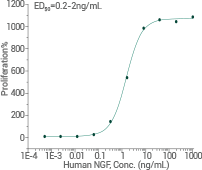
Image Credit: Sino Biological Inc.
- Purity: >95%
- Expressed host: CHO stable cells
- Activity: Cell proliferation assay using TF-1 human erythroleukemic cells
BDNF (brain-derived neurotrophic factor)
The survival and upkeep of sensory neurons, retinal ganglia, some cholinergic neurons, spinal motor neurons, and a few dopaminergic neurons are all supported by BDNF.
Mouse BDNF protein: 50240-M08H

Image Credit: Sino Biological Inc.
- Purity: >95%
- Expressed host: HEK293 Cells
Neurotrophin 3/NT3
Human NT3 protein: 10286-HNAE
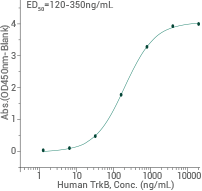
Image Credit: Sino Biological Inc.
- Purity: >90%
- Expressed host: E. coli
- Activity: Binding ability in a functional ELISA, bind to human TrkB
Neurotrophin 4/NT4
Human NT4 protein: 10265-HNAE
- Purity: >95%
- Expressed host: HEK293 Cells
Trk receptors
Human TrkA protein: 11073-H03H
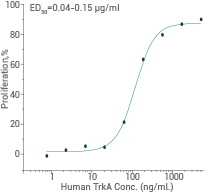
Image Credit: Sino Biological Inc.
- Purity: >95%
- Expressed host: HEK293 Cells
- Activity: Ability to inhibit NGF-induced proliferation of TF-1 human erythroleukemic cells
Human TrkC protein: 10048-H08H
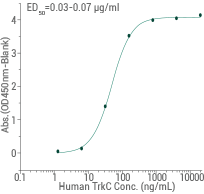
Image Credit: Sino Biological Inc.
- Purity: >95%
- Expressed host: HEK293 Cells
- Activity: Immobilized human TrkC can bind biotinylated human NT3 (Cat#:10286-HNAE)
List of recombinant Trk receptors
Table 1. Source: Sino Biological Inc.
| Cat# |
Molecule |
Species |
Expressed Host |
Purity |
Tag |
Activity |
| 11073-H03H |
TrkA |
Human |
HEK293 Cells |
>98% |
C-hFc & His |
Active |
| 11073-H07E1 |
TrkA |
Human |
E. coli |
>97% |
N-His |
Active |
| 51103-M02H |
TrkA |
Mouse |
HEK293 Cells |
>90% |
C-hFc |
Active |
| 51103-M08H |
TrkA |
Mouse |
HEK293 Cells |
>95% |
C-His |
Active |
| 70101-D01H |
TrkA |
Canine |
HEK293 Cells |
>90% |
N-hFc |
Active |
| 70101-D07H |
TrkA |
Canine |
HEK293 Cells |
>95% |
N-His |
Active |
| 80404-R02H |
TrkA |
Rat |
HEK293 Cells |
>95% |
C-hFc |
Active |
| 80404-R08H |
TrkA |
Rat |
HEK293 Cells |
>95% |
C-His |
Active |
| 10047-H03H |
TrkB |
Human |
HEK293 Cells |
>90% |
C-hFc & His |
Active |
| 10047-H08H |
TrkB |
Human |
HEK293 Cells |
>97% |
C-His |
Active |
| 50132-M08H |
TrkB |
Mouse |
HEK293 Cells |
>98% |
C-His |
Active |
| 70035-D08H |
TrkB |
Canine |
HEK293 Cells |
>95% |
C-His |
Active |
| 80243-R08H |
TrkB |
Rat |
HEK293 Cells |
>95% |
C-His |
Active |
| 10048-H03H |
TrkC |
Human |
HEK293 Cells |
>98% |
C-hFc & His |
Active |
| 10048-H08H |
TrkC |
Human |
HEK293 Cells |
>95% |
C-His |
Active |
| 50320-M08H |
TrkC |
Mouse |
HEK293 Cells |
>95% |
C-His |
Active |
Low-affinity common receptor to neurotrophins: p75NTR
Human p75NTR protein 13184-H08H
- Purity: >95%
- Expressed host: HEK293 Cell
- Citation: Cited by 26687096 (PubMed ID)
Mouse p75NTR protein 50971-M02H
- Purity: >90%
- Expressed host: HEK293 Cell
- Activity: Inhibit NGF-dependent proliferation of TF-1 human erythroleukemic cells. ED50 is 0.5-3 μg/mL in the presence of 2 ng/mL Recombinant mouse NGF
GDNF and receptor complex
The neurotrophic factor (GDNF) derived from glial cell lines is essential for promoting motor neuron survival and axon outgrowth. Clinical trials are being conducted to assess it as a potential Parkinson’s disease treatment. GFL-like medications are also being created to treat addiction and neuropathic pain, among other conditions.
Neurturin (NRTN), artemin (ARTN), and persephin (PSPN) are members of the GDNF family of ligands (GFLs), which also includes GDNF. These substances each bind to GFRA1, GFRA2, GFRA3, and GFRA4, in that order.
The GDNF/GFRA1 complex causes the RET tyrosine kinase receptor to become phosphorylated, which in turn causes cell survival, proliferation, and development via the MAPK/ERK or PI3K/Akt pathways.
GDNF/GFRA1 complexes with NCAM to cause axonal expansion. GDNF and other growth factors can work together, such as transforming growth factor-β (TGF-beta).
Sino Biological has created a variety of recombinant GDNF and GFRA1 proteins and antibodies from different species, including canine, mouse, rabbit, rat, and cynomolgus.
When treating Parkinson’s disease, GDNF is crucial. In common with other members of the GDNF family of ligands, GDNF binds to GFR-1 and the Ret protein. Sino Biological has created bioactive recombinant growth factors from many different species, including canine, cynomolgus, rat, mouse, and human.
Recombinant GDNF and GFRA1 proteins
Human GDNF protein 10561-HNCH
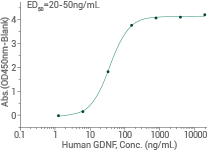
Binding ability by ELISA. Immobilized human GFRA1 (Cat:10330-H02H) at 10 μg/mL (100 μL/well) can bind GDNF. Image Credit: Sino Biological Inc.
Rat GDNF protein 80050-R07B
- Purity: >95%
- Expressed host: Insect cell
- Activity:
- Bind rat GFRA1
- Cell proliferation
Canine GDNF protein 70255-D01H
- Purity: >90%
- Expressed host: HEK293 Cell

Figure 2. GDNF ligand dimer binds to two GFRα receptors and dimerises two RET receptors. Image Credit: Sino Biological Inc.
Rat GFRα1 protein 80021-R02H
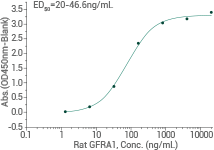
Binding ability by ELISA. Immobilized rat GDNF (Cat: 80050-R07B) at 10 μg/mL (100 μL/well) can bind rat GFRA1. Image Credit: Sino Biological Inc.
More GFRα1 proteins
Table 2. Source: Sino Biological Inc.
| Cat# |
Species |
Expressed Host |
Tag |
Purity |
Activity |
| 10330-H02H |
Human |
HEK293 Cells |
hFc |
>90% |
Active |
| 10330-H08H |
Human |
HEK293 Cells |
His |
>98% |
Active |
| 50171-M08H |
Mouse |
HEK293 Cells |
His |
>98% |
Active |
| 70062-D08H |
Canine |
HEK293 Cells |
His |
>95% |
|
| 80021-R02H |
Rat |
HEK293 Cells |
hFc |
>90% |
Active |
| 80021-R08H |
Rat |
HEK293 Cells |
His |
>97% |
Active |
Human RET Protein 11997-H08H1
- Purity: 92%
- Expressed host: HEK293 Cell
Human RET protein 11997-H20B
- Purity: >90%
- Expressed host: HEK293 Cell
Other related proteins
- ARTN
- GFRA2
- GFRA3
- RET
- NCAM
- TGF-beta
Antibodies for GDNF and GFRA1
Sino Biological has created a panel of anti-GDNF and anti-GFRA1 antibodies that are suitable for use in ELISA, WB, IF, and ICC.
Anti-GDNF rabbit polyclonal antibody (Cat#: 207160-T02)
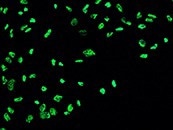
Immunofluorescence Staining of GDNF in U251MG Cells. Image Credit: Sino Biological Inc.
Anti-GFRA1 rabbit monoclonal antibody (Cat#: 50171-R009)
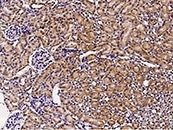
Immunochemical Staining of Mouse GFRA1 in Mouse Kidney Cells. Image Credit: Sino Biological Inc.
GDNF superfamily and receptors
Artemin/ARTN, neurturin/NRTN, and persephin/PSPN, members of the GDNF superfamily proteins, exhibit protective and restorative effects on both the developing and adult central nervous systems (CNS). GFRs 1, 2, 3, and 4 are respectively bound by GDNF, Neuturin, Artemin, and Persephin.
Human artemin protein 50176-M01H
- Purity: >90%
- Expressed host: HEK293 Cell
Human GFRα2 protein

Image Credit: Sino Biological Inc.
- Purity: >98%
- Expressed host: Expressed Host: HEK293 Cell
- Purity: >90%
- Expressed host: HEK293 Cell